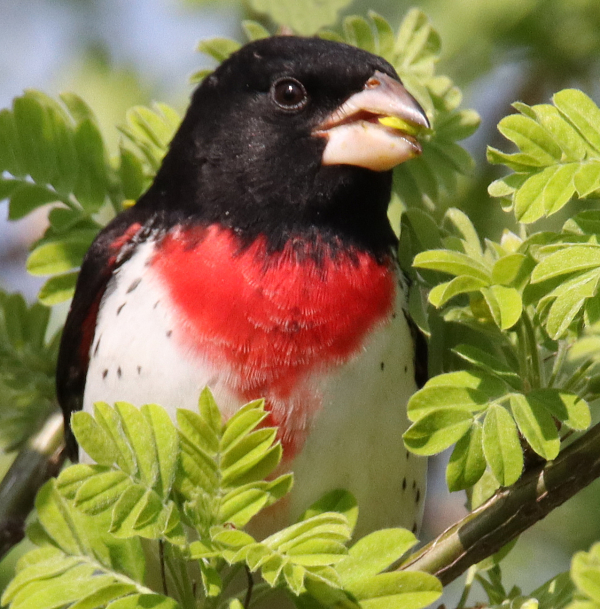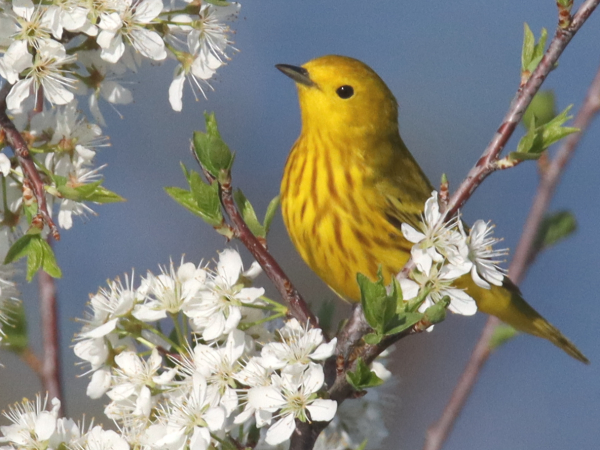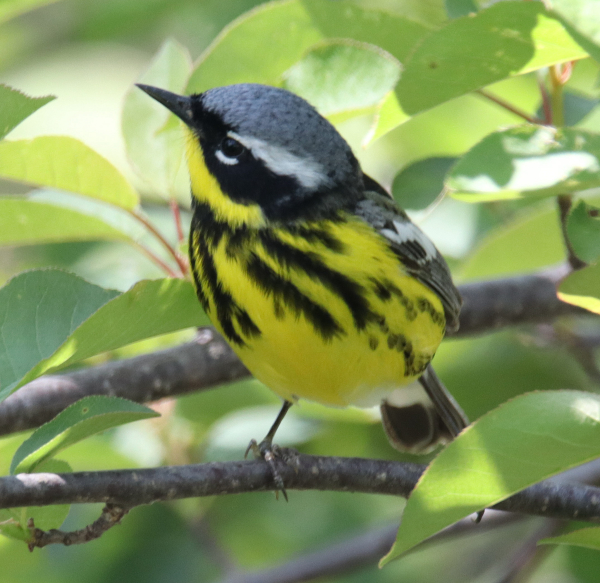
Monday morning’s first surprises were a number of Rose-breasted Grosbeaks, a species Paul hoped to photograph during this spring migration. Individuals even visited his feeding station.

Sunday evening provided many chances to photograph Yellow Warblers among abundant wild plum blooms. Other birds on hand included Clay-colored Sparrows and the first of season Orchard Oriole.

A white-headed, white-tailed hawk with a white underside – a Krider’s Red-tailed Hawk, which is a color variant of Red-tails, was on hand at its annual nesting territory.

Showing an almost complete molt into alternate plumage, this Dunlin’s black belly is still incomplete. An impressive variety of sandpipers was present at Charo Marsh Sunday evening, although they included only a few representatives of each species.

Photographed in the shadows near ground level Monday afternoon, at times the Magnolia Warbler was singing repeatedly from taller trees, an added treat provided by an early individual of a favorite warbler species.
|
On a beautiful Saturday morning – also Migratory Bird Day and Global Big Day – a nice initial wave of warblers enlivened Melody’s Grove, located just a few hundred yards from home. They included first of spring Palm Warblers, plus Yellow Warblers, Orange-crowned Warblers, Black-and-White Warblers, and mostly Yellow-rumped Warblers. At times I enjoyed 3 or 4 Yellow-rumps with a Yellow and Black-and-White all within view and camera range. There were also Swainson’s Thrushes, Brown Thrashers, American Robins, Common Grackles, and a Downy Woodpecker in the mix.
Melody’s Grove is the best migrant songbird “trap” in the area, and my other 2 “traps” weren’t very productive, which is a little surprising. You might think if one prime site has warblers the others would too, but often it’s one or another, which works out fine too. Melody’s Grove and nearby Melody’s Marsh are excellent birding locations, close to home, and they are named for the landowner who grew up on the vacated farmstead, across the road from my grandparents’ home. When I was very young, Melody was a pretty teen-aged girl who always stopped to say hello when we came from Bismarck to visit my grandparents – that’s the backstory. Today, I sometimes get a little nostalgic as I wait to photograph the next warbler under the tall cottonwood trees and the mix of trees and bushes in “the grove.”
During songbird migration, the grove is my first stop each morning and the last stop each eve as I check to test the pulse of songbird activity and species variety and abundance. I operate from the east side to use the morning sunlight, and switch to the west side to utilize the setting sun’s light – usually in hour-long increments, unless there is a lot of action, or none. I use my vehicle as a mobile blind, and I can drive forward and backward along the east side of the grove, depending on where the most warbler action is, or where rarer birds materialize. It’s an absolute blast, and a highlight of each May; no 2 Mays are the same for songbird abundance, variety, or timing, which makes it all the more interesting and intriguing – and it can change from hour to hour, day to day.
Marvelous Mother’s Day
Hoping for a healthy migrant fallout as I drove into Melody’s Grove, an impressive Harris’s Sparrow showed, as did a much smaller White-crowned Sparrow – a good omen considering I hadn’t seen either species for some days, suggesting an influx of migrants on what would become a festive Mother’s Day. Starting with a Yellow Warbler and Palm Warbler, with Yellow-rumps and Orange-crowns, and ending with a couple first of spring Blackpoll Warblers, the morning was a beauty.
Add to that the first downy yellow brood of Giant Canada Geese 3 miles south of my office, plus an opportunity to photograph Red-necked Grebes unison calling near the first of spring American Bittern that was displaying on the west side of Herb’s Lake. I checked for warblers at the Schoolhouse Grove, but instead found a small flock of Swainson’s Thrushes and a lone Lark Sparrow. The previous day this migrant trap would have been vacant except for one thrush that was obviously redder than others I’ve been seeing – a possible Veery? That would be a long shot, and I only had a quick glance as it flew, but when I walked in the direction of its flight I spied the thrush in time to get a photo as it flushed.
I checked on the variations in plumage color for Swainson’s Thrushes on the Birds of the World website, along with a look at Veery and Wood Thrush photos there. I almost wrote off the red thrush as a Swainson’s, but when I checked the snap photo I took, it clearly showed the thrush was a Veery. That’s when I remembered a Veery had suddenly appeared before me at Melody’s Grove a few years ago, my only other Veery sighting in the area, the region, and the state! Woo-woo!
During an evening birding drive, the groves were quite quiet, but a check on the now blooming wild plum trees on the edge of White Lake provided chances to photograph Yellow Warblers and Clay-colored Sparrows, which was exhilarating, especially when the first of spring Orchard Oriole joined the fun. As I drove down the dirt road to Charo Marsh I marveled at the euphoria I felt after that bird photography episode, almost forgetting about the shorebird potential at Charo until I topped the little hill that revealed an impressive variety of sandpipers.
Starting with the big ones, there was a pair of American Avocets, a pair of Willets, a lone Marbled Godwit (which probably signals its mate is incubating eggs), Greater and Lesser Yellowlegs, and a surprise Dunlin that had about half its black belly feathers with fully colored dorsal plumage. It towered over a Least Sandpiper and a Pectoral Sandpiper, while several Wilson’s Phalaropes were foraging in the beautifully blue water, some spinning in the process. Three Spotted Sandpipers and a pair of Killdeer rounded out the diverse group that lined 100 yards of shore as late afternoon turned to evening. In all, it was a truly marvelous Mother’s Day!
Melody Monday
Rose-breasted Grosbeaks were the name of the game early Monday, starting with 2 males positioned low in some bushes that were beginning to flower, seemingly resting and preening, but eventually I managed a couple photos as they began feeding on blooms. Melody’s Grove seemed to be lacking in warbler action though, so I circled back to the entry road where I encountered 3 male grosbeaks feeding fairly high in some tall cottonwood trees, and I followed each one as they worked their way through the mostly open canopy.
The angle of lighting wasn’t great, nor was the angle of the birds, but I had a little fun with it until the birds vacated. I checked the east side of the grove again with little action beyond a couple Yellow-rumps and Yellow Warblers, Least Flycatchers, Swainson’s Thrushes, and Northern Flickers. Therefore, I headed southeast a dozen miles with stops at Herb’s Lake to check on the Red-necked Grebes, the Schoolhouse Grove, and the flowering wild plum trees along White Lake, but things were remarkably quiet along the way, so I kept moving and returned to Melody’s Grove.
Considering the rest of the morning, including my initial check on the warbler action at the grove, I didn’t have high hopes as I returned after noon. It was really time to head for my office, but almost immediately a Mourning Warbler popped into view and fired my pulse up as I tried to follow its quick movements along bushes and trees. It seemed a bit early to encounter a Mourning Warbler, but I’m always glad to see and study these interesting birds. This individual was obviously more active than most Mourning Warblers I’ve encountered, and it foraged quite high into open trees that were just getting leaves. Usually Mourning Warblers stay low, a foot or so above ground level, keeping to the shadows and suddenly appearing from behind a cluster of leaves. This one was definitely active.
As it entered the foliage of an ash tree, I noticed another warbler, so took a look through binoculars and must have gasped to see a beautiful male Magnolia Warbler foraging. Now my attention was divided between 2 of my favorite warbler species, both within my view at the same time. Having had a pretty good photo session – if you can call it that – with the Mourner, I followed the Magnolia with my camera lens, hoping for a signature photo op. Where were these birds earlier when the light was right?
Now, with the sun overhead, it was tough to get a photo when the Magnolia was in open sunlight, or in full shade; but I kept vigilant, and eventually the colorful warbler not only foraged closer, but also positioned in the shade a bit below my car’s window level. I usually prefer to have direct sunlight to illuminate my photographs, opting not to photograph under cloudy or shaded circumstances; but considering the situation and the outcome, I’m glad to have had the option to take a few frames in the shade that provided some very pleasing images.
That afternoon, I tried my best to conjure up some primo birds, but just one appeared, at the flowering wild plum thicket – a first of season Common Yellowthroat, but it was the only warbler. I also witnessed a pair of Swainson’s Hawks building a nest along my regular route to Charo Marsh, so it will be nice to keep in touch with that pair’s progress.
Migrating Birds at Home
Last Thursday, I witnessed a migrant fallout in my yard that included a Ruby-crowned Kinglet, a Yellow-rumped Warbler, an Orange-crowned Warbler, and 4 Hermit Thrushes along with 10 White-throated Sparrows, a lone White-crowned Sparrow, and a first of spring Lincoln’s Sparrow. Later there were also 3 Clay-colored Sparrows to top off a great early spring mix of migrating songbirds!
Knowing the earliest return date for orioles has been May 10th in my area of the Northern Plains, last Wednesday (the 8th) I revamped my feeding station to position my oriole feeder in the center with my hummingbird feeder 2 feet away in anticipation for the circus that would soon begin. My oriole feeder was loaded with 2 sliced orange halves and its glass bowl was filled with grape jelly. House Finches were the first to taste the jelly, with American Robins a close second. Friday the 10th, the first of spring Gray Catbird appeared for jelly, and Saturday a Swainson’s Thrush awkwardly tasted the jelly – a first for that species, and I haven’t seen one try it since.
As I returned from my morning photo adventure Sunday, a beautiful adult male Baltimore Oriole was eating orange citrus – Hooray! And less than an hour later, as I was writing I looked up to see a big surprise – a striking male Rose-breasted Grosbeak! Although it was initially perched on a shepard’s crook, it dropped down to eat some bites of jelly before leaving. WoW, after having a feeding station that’s been all but vacant for a couple weeks, this was quite a thrill, and it’s just the beginning!
The oriole and grosbeak returned several times while I was home Sunday afternoon, but neither returned Monday; only the prettiest female Rose-breasted Grosbeak I’ve seen was on hand a number of times. But Tuesday there were at least 3 Baltimore Orioles visiting, including a mature female. Things are just getting interesting at my feeding station, and I should have some real excitement to share next week.
This is truly an exciting time of year – every day brings new birds and new bird behaviors that reveal some of the reasons we enjoy birding so much. As an associate of mine liked to say, “We are so lucky to appreciate birds the way we do,” and it’s a reflection of our interest in the earth and its nature, just as birds are the best reflection of nature itself. Enjoy the time you can devote to birding, and spend a little extra time with each bird, just to see what happens next. Happy Birding!
Article and photos by Paul Konrad
Share your bird sightings and photographs at editorstbw2@gmail.com